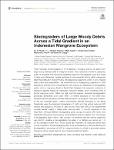Biodegraders of Large Woody Debris Across a Tidal Gradient in an Indonesian Mangrove Ecosystem
| dc.contributor.author | Hendy, IW | |
| dc.contributor.author | Shipway, JR | |
| dc.contributor.author | Tupper, M | |
| dc.contributor.author | Etxabe, AG | |
| dc.contributor.author | Ward, RD | |
| dc.contributor.author | Cragg, SM | |
| dc.date.accessioned | 2023-11-27T18:03:30Z | |
| dc.date.available | 2023-11-27T18:03:30Z | |
| dc.date.issued | 2022-05-25 | |
| dc.identifier.issn | 2624-893X | |
| dc.identifier.issn | 2624-893X | |
| dc.identifier.other | ARTN 852217 | |
| dc.identifier.uri | https://pearl.plymouth.ac.uk/handle/10026.1/21711 | |
| dc.description.abstract |
There has been limited research on the breakdown, recycling, and flux of carbon from large woody detritus (LWD) in mangrove forests. The breakdown of LWD is caused by guilds of terrestrial and marine biodegrading organisms that degrade wood at a range of rates and efficiencies. Spatial variations in environmental factors within mangroves affect the distribution and community of biodegrading organisms, which, in turn, impacts carbon flow and sequestration. We reveal the role of biodegrading organisms in LWD breakdown and the environmental factors that influence the distribution of biodegrading guilds within a mangrove forest in South East Sulawesi that supports a diversity of mangrove species typical of Indonesian mangrove forests, which constitute 20% of Global mangrove cover. Within the high intertidal regions, terrestrial biodegradation processes dominated upon LWD. After 12 months exposure on the forest floor, experimental wooden panels in these areas remained unchanged in mass and condition. In the low intertidal region, marine wood-boring animals belonging to the family Teredinidae were the dominant biodegraders of LWD, and their activity reduces LWD volume and speeds up the loss of LWD volume. More than 50% of the experimental wooden panels’ weight in these areas was lost after 12 months exposure on the forest floor. Although different biodegrading guilds occupy the same LWD niche, their distribution throughout the mangrove forest is influenced by inundation time. The change of biodegrading guilds within LWD between the terrestrial and the marine organisms was distinct, creating a biodegradation boundary in a distance as narrow as 1 m on the mangrove forest floor. These results are important, as rising sea levels have crucial implications for biodegrading guilds. A full understanding of factors affecting the biodegradation processes of LWD in mangrove forests is critical to accurately assess mangrove carbon stores and the fate of mangrove derived carbon. | |
| dc.format.extent | 852217- | |
| dc.publisher | Frontiers Media SA | |
| dc.subject | coastal wetlands | |
| dc.subject | biodegradation | |
| dc.subject | blue carbon | |
| dc.subject | wood decay | |
| dc.subject | fungi | |
| dc.subject | shipworms | |
| dc.subject | carbon cycling | |
| dc.subject | sea level rise (SLR) | |
| dc.title | Biodegraders of Large Woody Debris Across a Tidal Gradient in an Indonesian Mangrove Ecosystem | |
| dc.type | journal-article | |
| dc.type | Article | |
| plymouth.author-url | https://www.webofscience.com/api/gateway?GWVersion=2&SrcApp=PARTNER_APP&SrcAuth=LinksAMR&KeyUT=WOS:001026988600001&DestLinkType=FullRecord&DestApp=ALL_WOS&UsrCustomerID=11bb513d99f797142bcfeffcc58ea008 | |
| plymouth.volume | 5 | |
| plymouth.publication-status | Published online | |
| plymouth.journal | Frontiers in Forests and Global Change | |
| dc.identifier.doi | 10.3389/ffgc.2022.852217 | |
| plymouth.organisational-group | |Plymouth | |
| plymouth.organisational-group | |Plymouth|Faculty of Science and Engineering | |
| plymouth.organisational-group | |Plymouth|Faculty of Science and Engineering|School of Biological and Marine Sciences | |
| plymouth.organisational-group | |Plymouth|REF 2021 Researchers by UoA | |
| plymouth.organisational-group | |Plymouth|Users by role | |
| plymouth.organisational-group | |Plymouth|Users by role|Academics | |
| plymouth.organisational-group | |Plymouth|REF 2021 Researchers by UoA|UoA07 Earth Systems and Environmental Sciences | |
| plymouth.organisational-group | |Plymouth|REF 2028 Researchers by UoA | |
| plymouth.organisational-group | |Plymouth|REF 2028 Researchers by UoA|UoA07 Earth Systems and Environmental Sciences | |
| dcterms.dateAccepted | 2022-05-02 | |
| dc.date.updated | 2023-11-27T18:03:29Z | |
| dc.rights.embargodate | 2023-11-29 | |
| dc.identifier.eissn | 2624-893X | |
| rioxxterms.versionofrecord | 10.3389/ffgc.2022.852217 |


